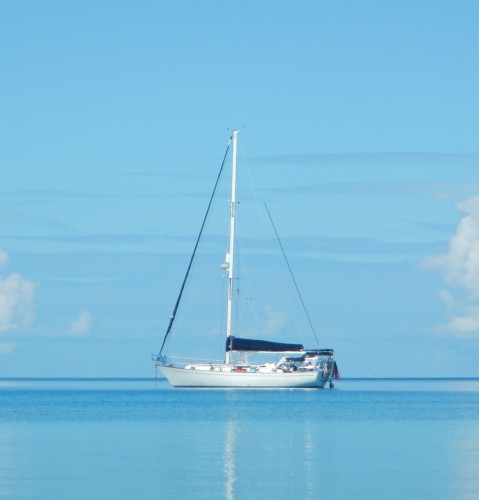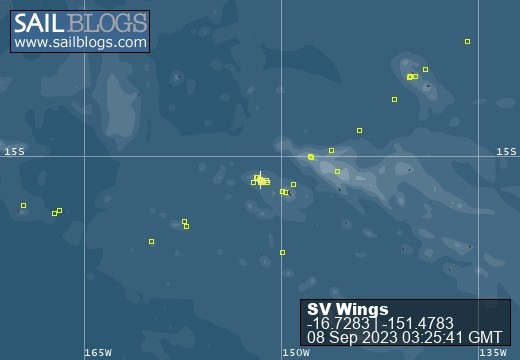
Voyages
These are the voyages of the sailing vessel, Wings.
19 September 2023 | Pension Tiare Nui
15 September 2023 | Pension Tiare Nui
13 September 2023 | Pension Tiare Nui
11 September 2023 | Pension Tiare Nui
07 September 2023 | Apooiti Bay
03 September 2023 | Tapuamu, Taha'a
02 September 2023 | Tapuamu, Taha'a
31 August 2023 | Haamene Bay, Taha'a
29 August 2023 | Relais Mehana Hotel, Huahine
26 August 2023 | Fare, Huahine
19 August 2023 | Aloe Cafe, Viatape
13 August 2023 | Aloe Cafe, Viatape
11 August 2023 | Apooiti Bay
11 August 2023 | Apooiti Bay mooring field
08 August 2023
08 August 2023 | Apooiti Bay, Raiatea
05 August 2023 | Raiatea Carenage
01 August 2023 | Raiatea Carenage
31 July 2023 | Raiatea Carenage
28 July 2023 | Orion Guest House
We Leave La Paz!
20 March 2012 | Ensenada de Raza
Joyous Bill!
Up at 7:30, we were consuming strong coffee by 8:30 with everyone awake. After a frantic but ultimately successful boat search for the two dock lock keys (US$50 deposits each!), Conni traipsed to the marina office to clear us out. We dropped by the fuel dock and filed empty diesel tanks with that good old cheap Pemex fuel for a lot less than we usually spend. We know that Mexico is using its petroleum reserves at an alarming rate, but it's nice to pay so little for diesel.
With all our instruments feeding us data, we headed down the narrow channel to the open Sea of Cortez, with the shallows coloring the waters all around us. Jeez, going around would be easy!
We had had issues with the new Raymarine sounder that we installed in Alameda last year, but while the boat was still on the hard, we removed the paddlewheel assembly from the "triducer" (speed, depth, water temperature) and found that the data connection band on the triducer was corroded, and some emery cloth cleaned it quickly. So far, that simple fix has worked. It's nice to know the boat speed through the water, but the instrumentation uses boat speed and direction through the water to calculate the true wind speed and direction, a very useful set of data. We didn't really need another depth sounder since we have our Interphase forward-looking sounder, but redundancy on this vital instrument is worthwhile. It's nice to have the full complement of instruments working so well.
Winds continued to rise all morning, and finally we had 30 kts on the bow, while we made 3 kts through the water. When we finally changed our heading enough to make use of the wind, we unfurled the jib but did not deploy the main. We had forgotten to tie in the main reef lines! Dummies! There was too much wind to tie them in while raising it, so we made our way by engine and jib.
About half way to Isla Espiritu Santo, I dropped the fishing line into the water and in short order we had hooked a fish. It didn't just jump into the boat, either! The open-faced reel got a giant tangle that had to be untangled while keeping the fish on the line, but we did manage. What a fight! It took about twenty minutes to bring it alongside and it put up a great fight the entire time. It was not a large fish but fought as much as a large Silver Salmon. We bonked it on the head, slit a gill or two, and let it trail in the water to bleed out. We did manage not to cover the boat sides with fish blood this time. None of us has an idea of the species of this fish, but we're all convinced that it's a tuna: thick pieces of dark red meat seem to be tuna to us. [The fish was later identified as a Black Skipjack. "It is normally an incidental catch on live sardinas, rapidly trolled feathers or hootchies, or off the bottom with chrome yo-yo iron. For their size they put up a horrific fight. They are viewed by locals as a bait fish returned immediately to the deep or cut into chunks." We ate it!]
I quickly took the fish to the galley and filleted it, so in twenty minutes it went from swimming to the reefer. Thanks, fish.
The terrain along the west coast of the island is beautiful but stark and unique. Be sure to check the site for photos. It appears to be pyroclastic covered by sedimentary or, perhaps meta-sedimentary. Interesting and like nothing we've ever seen.
After arriving in Ensenada de Raza, we dropped our anchor in the "good holding sand" as described in the guide. Lucky for us, since the wind has continued unabated. We'll still have to take a look now and again, but at least we feel that we'll hold in place. In these enormous gusts, Wings will "fishtail" back and forth as the bow catches the wind and gets pushed downwind. That puts the high-windage sides into the flow, and the boat finally straightens bow-on into the wind. In the 30 kt gusts, we even rattle a few feet of chain through the windlass. Since we're in only 15 feet of water, we can put down 180 feet of chain and gain a 12:1 scope. Jeez, that should be sufficient! For those Alaskan boaters reading this, that's 1-5 feet of water! We're getting used to it, but slowly.
Tonight, after a round a cocktails, we'll try fish tacos.
With all our instruments feeding us data, we headed down the narrow channel to the open Sea of Cortez, with the shallows coloring the waters all around us. Jeez, going around would be easy!
We had had issues with the new Raymarine sounder that we installed in Alameda last year, but while the boat was still on the hard, we removed the paddlewheel assembly from the "triducer" (speed, depth, water temperature) and found that the data connection band on the triducer was corroded, and some emery cloth cleaned it quickly. So far, that simple fix has worked. It's nice to know the boat speed through the water, but the instrumentation uses boat speed and direction through the water to calculate the true wind speed and direction, a very useful set of data. We didn't really need another depth sounder since we have our Interphase forward-looking sounder, but redundancy on this vital instrument is worthwhile. It's nice to have the full complement of instruments working so well.
Winds continued to rise all morning, and finally we had 30 kts on the bow, while we made 3 kts through the water. When we finally changed our heading enough to make use of the wind, we unfurled the jib but did not deploy the main. We had forgotten to tie in the main reef lines! Dummies! There was too much wind to tie them in while raising it, so we made our way by engine and jib.
About half way to Isla Espiritu Santo, I dropped the fishing line into the water and in short order we had hooked a fish. It didn't just jump into the boat, either! The open-faced reel got a giant tangle that had to be untangled while keeping the fish on the line, but we did manage. What a fight! It took about twenty minutes to bring it alongside and it put up a great fight the entire time. It was not a large fish but fought as much as a large Silver Salmon. We bonked it on the head, slit a gill or two, and let it trail in the water to bleed out. We did manage not to cover the boat sides with fish blood this time. None of us has an idea of the species of this fish, but we're all convinced that it's a tuna: thick pieces of dark red meat seem to be tuna to us. [The fish was later identified as a Black Skipjack. "It is normally an incidental catch on live sardinas, rapidly trolled feathers or hootchies, or off the bottom with chrome yo-yo iron. For their size they put up a horrific fight. They are viewed by locals as a bait fish returned immediately to the deep or cut into chunks." We ate it!]
I quickly took the fish to the galley and filleted it, so in twenty minutes it went from swimming to the reefer. Thanks, fish.
The terrain along the west coast of the island is beautiful but stark and unique. Be sure to check the site for photos. It appears to be pyroclastic covered by sedimentary or, perhaps meta-sedimentary. Interesting and like nothing we've ever seen.
After arriving in Ensenada de Raza, we dropped our anchor in the "good holding sand" as described in the guide. Lucky for us, since the wind has continued unabated. We'll still have to take a look now and again, but at least we feel that we'll hold in place. In these enormous gusts, Wings will "fishtail" back and forth as the bow catches the wind and gets pushed downwind. That puts the high-windage sides into the flow, and the boat finally straightens bow-on into the wind. In the 30 kt gusts, we even rattle a few feet of chain through the windlass. Since we're in only 15 feet of water, we can put down 180 feet of chain and gain a 12:1 scope. Jeez, that should be sufficient! For those Alaskan boaters reading this, that's 1-5 feet of water! We're getting used to it, but slowly.
Tonight, after a round a cocktails, we'll try fish tacos.
Comments
| Vessel Name: | Wings |
| Vessel Make/Model: | Passport 40 |
| Hailing Port: | Anchorage, Alaska |
| Crew: | William Ennis and Constance Livsey |
| About: | We've been married since 1991, and both retired from our respective jobs (teacher and attorney) after long careers. We live in the most exotic of the United States: Alaska. We cruise on Wings for half the year, enjoying our home state the other part of the year. |
| Extra: | |
| Home Page: | http://svwings.com |
Wings's Photos - Main
No items in this gallery.
Who We Are

Who: William Ennis and Constance Livsey
Port: Anchorage, Alaska

